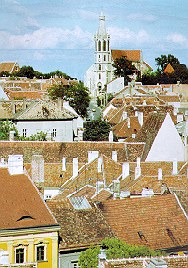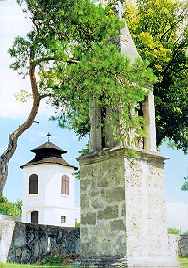
Thus parts lying to the east are named after Balf, those to the north after Bécs (Vienna) and after Gyõr on the south whilst the western district's name is Újtelek városrész (Újtelek district). The Balf and Vienna districts .
We begin our walk at a point along Várkerület already known to the visitor: Ikvahíd (Ikva Bridge) is the short street branching off opposite the Maria column. As its name indicates, the carriageway as well as the houses on either side are built across the brook named Ikva that flows past under the buildings. The previous name, Ispotályhíd (Hospice Bridge) referred to the hospital of the Knights of St John that stood on the site of No 2 Ikvahíd until 1798 when it was demolished together with the adjoining Szent Erzsébet templom (St Elisabeth Church). Before turning right into Balfi utca (Balf Street) let us glance up at the statue on the corner building.The stone figure of St Elisabeth with a leper at her feet dates from the 18th century. Balfi utca: The closed ranks of residential buildings traditionally belonged to farming families named 'poncichter'-s in the local dialect who owned and tended the vineyards and orchards around Sopron. Built in a plainer version of baroque, the line of houses follows that of the riverbed. The first mention of this old cobble-stoned street is found as early as 1413 under the German name Schrippengasse, a misspelling of the original Schlippengasse or Slipway. No 11 Balfi utca, a two-storey residence on the left, houses the Zettl-Langer private collection.
Its numerous works of art and curioes are well worth a brief visit. A walk of about a mile and a half along Balfi utca will take one to the Lutheran cemetery that was opened in 1886. Its wrought iron gates were transferred from the Erzsébet utca (Elisabeth Street) graveyard that was at one time situated in the centre of Sopron. Any of the side streets to one's right along Balfi utca will lead one back to the centre. Take Bem utca (named after a Polish general of Hungary's 1848-49 war of independence) to Paprét (Priests' Meadow) to see the country's first public gymnasium built in 1867, opposite which Joseph Weiss' chocolate factory once stood.
Halász utca (Fisherman's Street) runs parallel to Balfi utca. Its first mention dates from 1421. The Szentháromság kápolna (Trinity Chapel) of the Voss Orphanage at No 38 was built during the second half of the 18th century. The altarpiece was painted by Dorfmeister in 1772. It was also in this street, on the site of he present day comprehensive school that the barracks stood in which Sándor Petõfi spent 1839-40.
If coming from Várkerület, we turn left at the end of Ikvahíd, Szentlélek utca (Holy Spirit Street) will take us to Sas tér (Eagle Square). Szentlélek templom (the Church of the Holy Spirit) stands opposite the corner of Ikvahíd. The first mention of the small, originally gothic building is recorded in 1406. Its present day architectural character dates from 1782, the interior's fine frescoes were painted by Dorfmeister. The adjoining two-storey rectory building contains valuable paintings as well as a life-size statue of St John of Nepomouk in the entrance vault.
Sas tér, a square of irregular shape and small town atmosphere was at one time a most important junction of the roads leading to and from Vienna and Pozsony ( Bratislava). Its name derives from the Fekete Sas vendéglõ (Restaurant to The Black Eagle) that at one time occupied No 6. The street façade is ornamented with rococo pilasters.
From Sas tér Fövényverem (Sandpits) takes us uphill to Szent Mihály utca (St Michael's Street) past the former Jesuit Theological College, popularly known as the 'Colleum' at No 5 Fövényverem as well as No 1, the house of János Csányi, Sopron's chronicler. Szent Mihály utca is historically the most important street of the district. The staggered line of the street façades of the houses built mostly by farming families establishes a village character along the slope rising towards the church on top of the hill.
No 9 Szent Mihály utca, Two Mores House, is a fine example of vernacular baroque. The two single-story buildings are joined by an entrance flanked with 'cork-screw' columns terminating in Morish caryatides. The gables are decorated in swags, putti and stone window surrounds while St Rock and St Florian are represented by statues within niches. The central figures stading in the richly decorated arched recess are are those of the Virgin Mary and St Joseph.
No 33 Szent Mihály utca was built
in 1727 by a member of the Unger family of ornamental masons. The date
is visible set in a wreath of roses over the entrance. The stone figure
of St Sebastian stands in an arched niche with carved surround.

The Church of St Michael rises at Sopron's highest point. Records mention the building as early as the final quarter of the 13th century but construction work probably began many years before. Its present day architectural character dates from the second half of the 15th century. King Matthias is said to have attended the consecration ceremony when young. Thought to have been threatened by the invading Turks, the church was to be demolished but the clergy narrowly prevented this. Between the years 1565-1606 Roman Catholics and Protestants shared the use of the builing, mass and divine service alternating on Sundays. From 1606 St Michael's belonged to the Lutheran church, until in 1674 it passed into the ownership of the Roman Catholics. Significant interior elements include a Madonna statue from 1460, fine paintings and three ornate as well as eighteen plainer gothic chancel niches.
One of Sopron's oldest buildings, Szent Jakab kápolna (St Jacob's Chapel) stands in the churchyard. Its architectural character is a noted example of the transitional period between the romanesque and gothic styles. Originally the chapel of he butchers' guild, the building has undergone extensive restoration work. Having at one time functioned as an ossuary, it is now used as a funeral chapel.
Now let us take a left hand turn at the end of Szent Mihály utca into Bástya utca (Bastion Street) that will lead us to Bécsi út (the Vienna Road).
We will
walk past the remains of the city wall. Bástya utca meets Bécsi
út at the foot of Koronázó-domb (Coronation Mound)
where a stone column commemorates the coronation of the Emperor Ferdinand
III on 8th December 1625. It was here that he made the symbolic gesture
of slashing the air with his sword by way of warning off all would-be foes
of Hungary. Since the construction of the by-pass road it is in isolation
that we encounter here the folly named Esernyõs-ház (Umbrella
House) that once stood at No 42 Bástya utca. It was Mayor Kristóf
Lackner who encouraged the well-to-do burghers of Sopron to have such structures
built in their orchards and gardens. Although they were destroyed during
he early 18th century, the custom was revived after a few decades.

The Umbrella House was built in 1800 in the manner of the Chinese Pavilion set in the grounds of the Esterházy palace at Fertõd.
The Mariazell Cross where through the ages pilgrims gathered before setting out on their journey, stands nearby. It dates from 1670.
At the crossing of Bécsi út and Patak utca (Brook Street) we arrive at the erstwhile site of Bécsi kapu, (Vienna Gate) a major entry point into Sopron through the outer city walls.
The valley below is the site of the city's Roman amphitheatre, the outlines of which can still be discerned. Walking towards Sas tér we pass No 30 Bécsi út, the old Customs House as well as the Storno studio at No 25 and the gothic St Leonard Cross set at the Szélmalom utca (Windmill Street) junction in 1930.
The carved emblem of Vienna Gate is visible on the street façade of No 15 Bécsi út.
The two-storey building at No 8 Bécsi út is probably the one-time customs house of he Knightly Order of St John.
The aisleless Szent János templom (St John's Church) opposite was built in 1247.
The adjoining building stands on the former site of the monastery of the order whose members first settled in Sopron in the same year. Mihály Rupprecht notable local photographer lived at No 6 Bécsi út during the late 1880s.
No 5 Bécsi út accommodates the Bakery Museum. It was in this building that journeyman bakers put up for the night on their way to Austria. The exhibition is housed in the original interiors and includes a 17th century bakery and shop.
Our next walk of discovery takes us to the Újtelek and Gyõr districts.
It was due to the first railway construction projects that the development of Újtelek district accelerated during the second half of the 19th century. Building work on present day Kossuth utca (Kossuth Street) connecting the small square by Újtelek Gate with Déli pályaudvar (Southern Station) began in 1847. Rákóczi Ferenc utca (Ferenc Rákóczi Street) leads from this square to Széchenyi tér. The first mention of Újteleki utca is recorded in 1426. Erzsébet utca, leading to the station that serves the Gyõr-Sopron-Ebenfurt Railways, was laid out in 1873 after he closure of the Lutheran cemetery. Its architectural and town planning character is typical of the 19th century. The construction of Deák tér (Deák Square, named after the Hungarian statesman who played a primary role in bringing about the 1867 compromise between Austria and this country) was begun subsequent to Rák patak (Crayfish Stream) having been covered over in the 1880s. The buildings suffered extensive damage during World War II bombings. Several war memorials including some reminding us of World War I may be seen in the square that stretches in an east-west direction. The building of the former Lutheran Theological College terminates the axis to the east while the Calvinist Church stands at the westernmost corner, opposite the Museum. The two stone statues standing in front of the Museum symbolize Justice and at one time decorated he Old Town Hall. The Lenck Villa built in 1890 in classicist style has accommodated the Museum since 1913. Its local history collection includes folk arts and crafts exhibits. The old Lutheran cemetery's finest 17th and 18th century grave stones are displayed along the garden walls.
Let us now become acquainted with Gyõr district by first walking along Ötvös utca or Móricz Zsigmond utca. Magyar utca (Hungarian Street) begins at he junction of these two streets. It was so named because it was via this route that one was able to reach the areas inhabited by Hungarians. A walk along Magyar utca will take us to Kõfaragó tér (Mason's Square). It occupies the site in front of the now demolished Magyar Kapu (Hungarian Gate) that once stood at the beginning of the road to Gyõr. No 9 Kõfaragó tér is the Small Town Hall built in classicist style. We may also see in the square a baroque statue of St John of Nepomouk and at the corner of Magyar utca a column that was once part of the nearby city gates.
From Kõfaragó tér let us walk along Fapiac, (Timber Market) past Sopron's newest church, to reach Kuruc domb (Kuruc Mound) named after the participants of the Rákóczi uprising. It was from this hill that Rákóczi's troops led by János Bottyán, fired their cannons on Sopron in 1705. The windmill constructed on top of the mound in the early 1800s is of architectural interest. Híd utca (Bridge Street) is a continuation of Fapiac, Lehár Ferenc utca (Franz Lehar Street) is one of its side streets. It was at No 5 that Franz Lehár spent some of his childhood years. Now let us take a turn from Fapiac into Pócsi utca that will lead us back to Magyar utca along a direction parallel to the outer city walls.
Walks . . . * Welcome * 1. walk * 2. walk * 3. walk * 4. walk